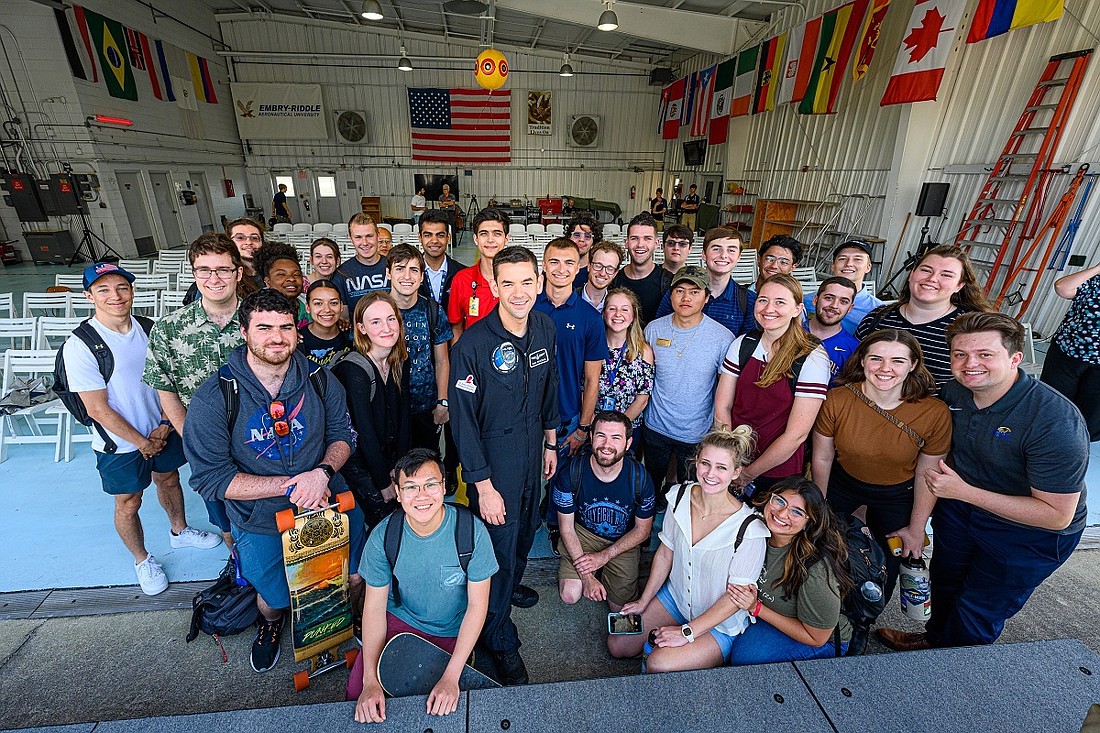- December 26, 2024
-
-
Loading

Loading

by: Mike Cavaliere
Director of News & Media Relations, Embry-Riddle
Polaris Dawn Commander and Embry-Riddle Aeronautical University alumnus Jared Isaacman (2011), who last year led the first all-civilian space mission, visited Embry-Riddle’s Space Technologies Laboratory last week to see a new multi-camera system in development that will fly aboard a SpaceX Dragon capsule to capture video of the first commercial spacewalk.
Polaris Dawn is the first mission in the Polaris Program, which consists of up to three human spaceflight missions that will demonstrate new technologies, conduct extensive research and culminate in the first flight of SpaceX’s Starship with humans on board. As for Embry-Riddle’s involvement in the mission, it does not end at the camera’s construction, according to Dr. Troy Henderson, Space Technologies Lab director and associate professor of Aerospace Engineering. In addition, the team will endeavor to use the camera imagery to create virtual reality simulations later. They also plan to test thermal-management material.
“With the successful delivery of EagleCam hardware, the Polaris team approached us about providing a camera payload for the Polaris Dawn mission — and of course the students jumped at the opportunity,” Henderson said. “ ... Who wouldn’t want to be part of the first-ever commercial spacewalk?”
In addition to previously leading the Inspiration4 mission, Isaacman is also CEO of Shift4 and founder of Draken International. Similar to Inspiration4, which raised over $240 million for St. Jude Children’s Research Hospital, the Polaris Dawn mission will also work to advance scientific research to improve human health, while continuing to raise funds and awareness for St. Jude.
The footage obtained on the spacewalk "will provide invaluable data for future spacesuit design and potential future CubeSat deployment mechanisms,” Isaacman said.
Polaris Dawn is currently scheduled for liftoff no earlier than the fourth quarter of 2022. Previously, the Embry-Riddle Space Technology Team developed the EagleCam camera system, which will travel to the moon with the Intuitive Machines Nova-C Lunar Lander, also scheduled for a late-2022 launch.
Also during his visit to Embry-Riddle, Isaacman spoke about his spaceflight and aviation career, as the featured keynote speaker for Aviation Week 2022.
Issacman was interviewed by students Alijah McDonald and Niko Blanks, with Worldwide Campus Dean of the College of Aeronautics Ken Witcher moderating. McDonald is an Aerospace Engineering student and Boeing Scholar, set to intern at The Boeing Company this summer. Blanks, who is a pediatric cancer survivor, is studying Spaceflight Operations and will work for Blue Origin this summer.
“This is such an exciting time for human spaceflight,” Issacman said.
He cited seeing the moon rise from aboard a spacecraft orbiting Earth as an especially memorable moment which made him realize how much more exploration is needed.
“We can’t let this momentum slow down,” he said. “We’ve just got to keep going.”
Some of Isaacman’s favorite moments in orbit were watching his crew members simply be themselves in microgravity, he said, recalling Chris Sembroski (2007) playing his ukulele and Dr. Sian Proctor doing her artwork. He said another big goal of his mission was to show that everyday people can go to space.
The next step is going to the moon as part of the Polaris Dawn mission, with an eventual goal of putting people on Mars, he said.
He encouraged students interested in working in the space industry to follow their dreams, adding that there are exciting opportunities throughout this emerging field.
“Just aim high,” Isaacman told students. “This is the time to do it.”
Watch Isaacman’s full presentation online.